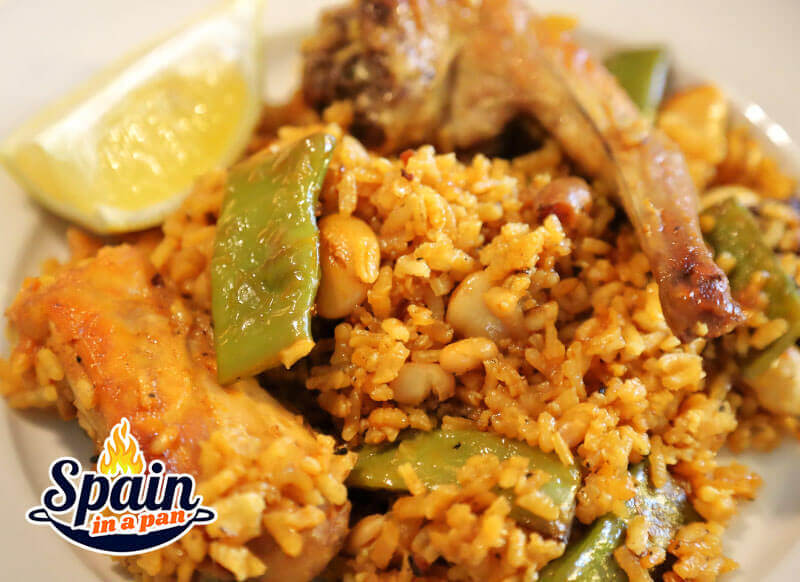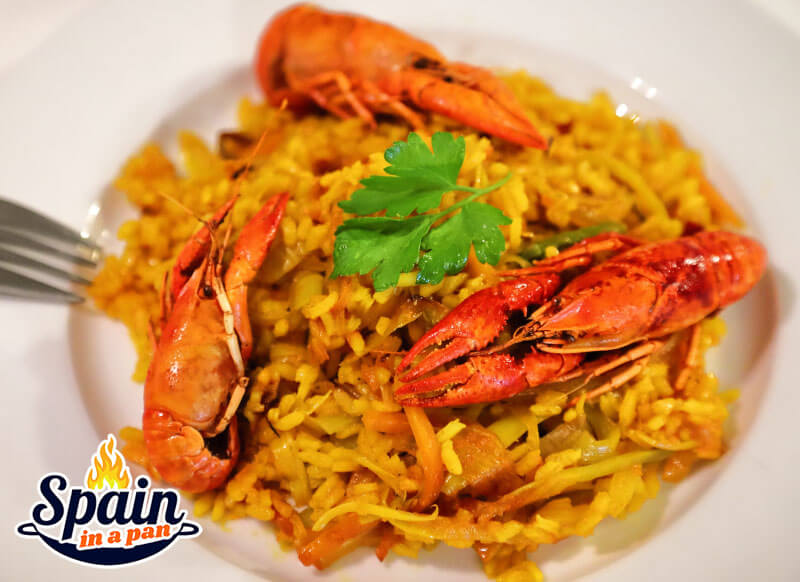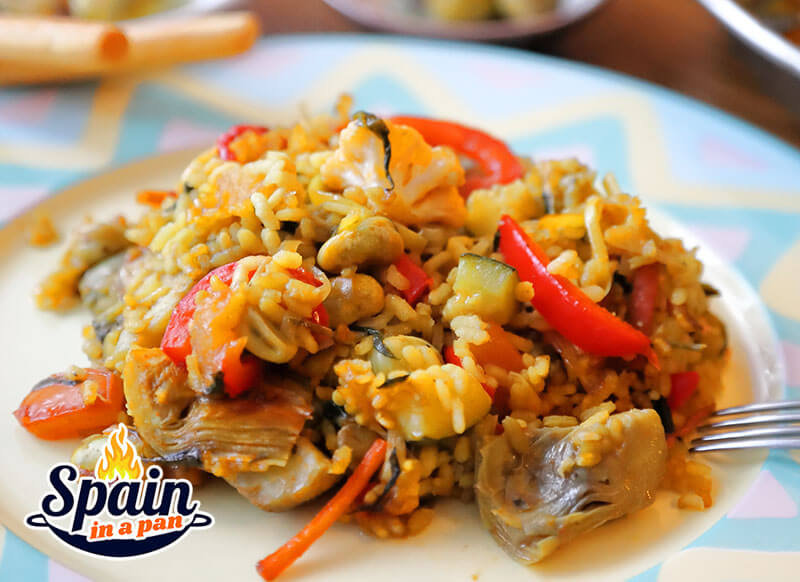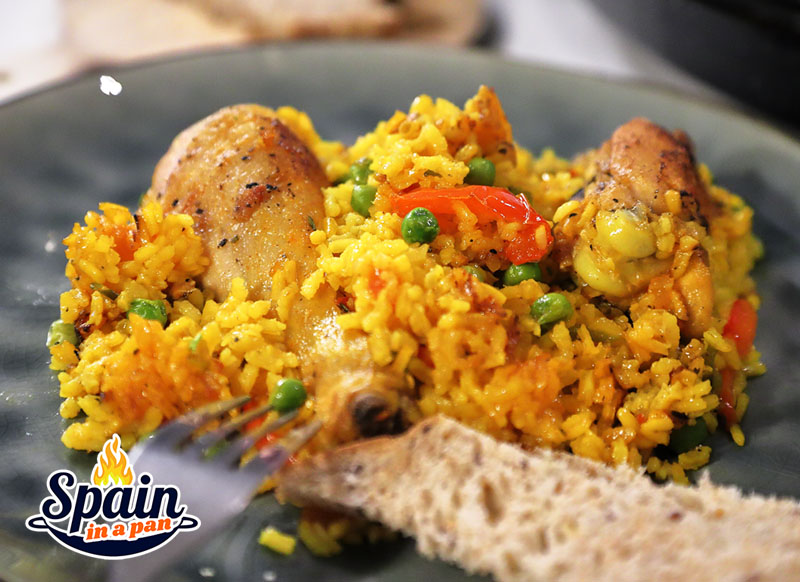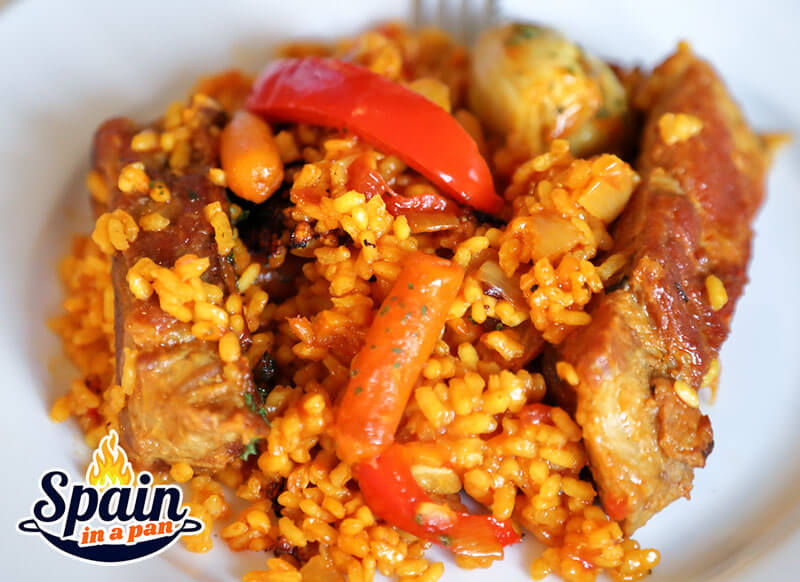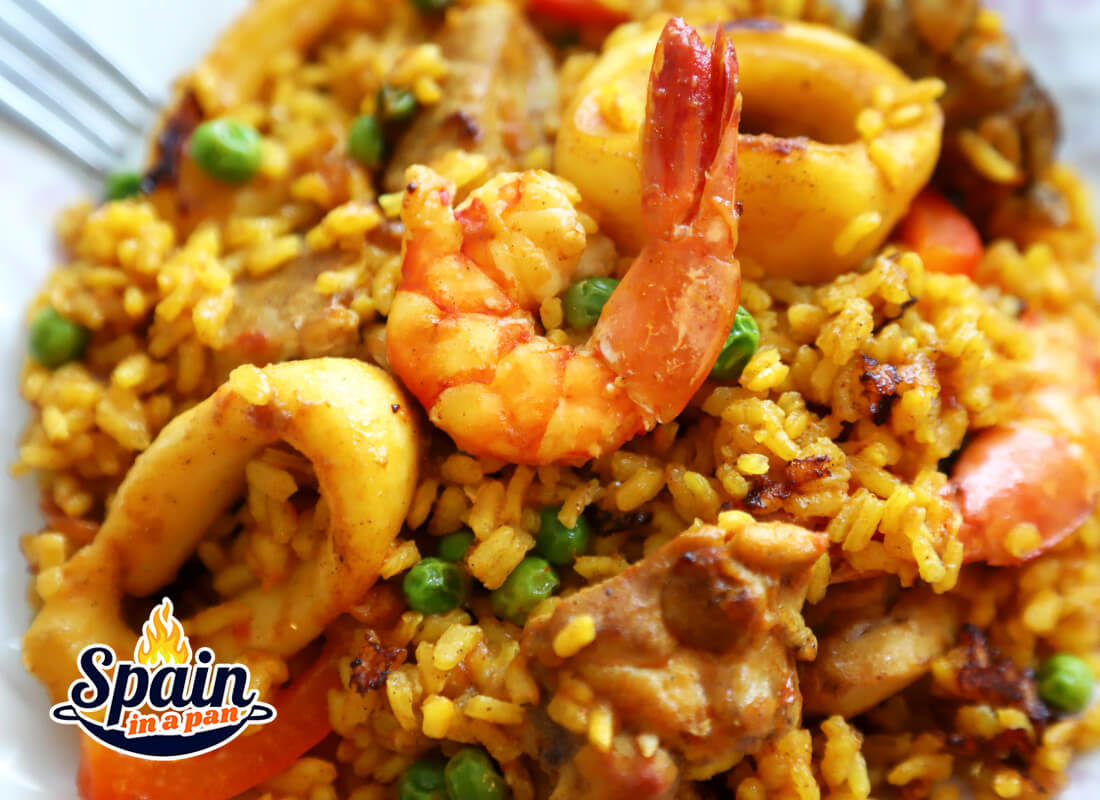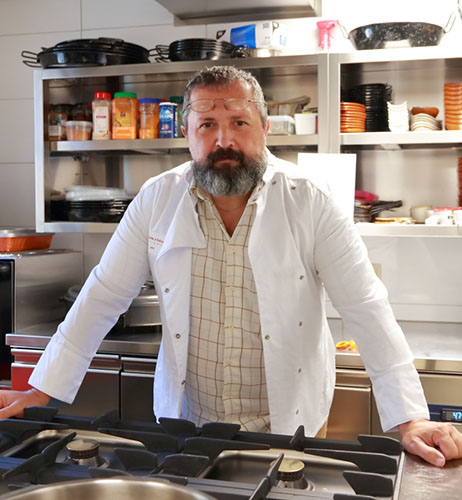- HOME
- Paella Techniques
How to Make Paella Perfect? Technique Secrets!
By Edu Valor / Author - Spanish Chef
Without holding anything back, you will now learn how to make paella, including the Valenciana, the right way! Revealing these technique secrets will irritate a few Valencian restaurant chefs.
These are cooking techniques of pros, step by step! You might want to share this one. Find the full recipe of the authentic paella on this link!
I assume you own a genuine paella pan with a gas burner or an electric one.
Very important! Before you start, make sure the pan is level!
- Pour olive oil (25ml/1.5 tbsp per person) into the pan. If it stays in the middle of the pan, you’re done! Otherwise, make corrections on the side where the oil flows to.
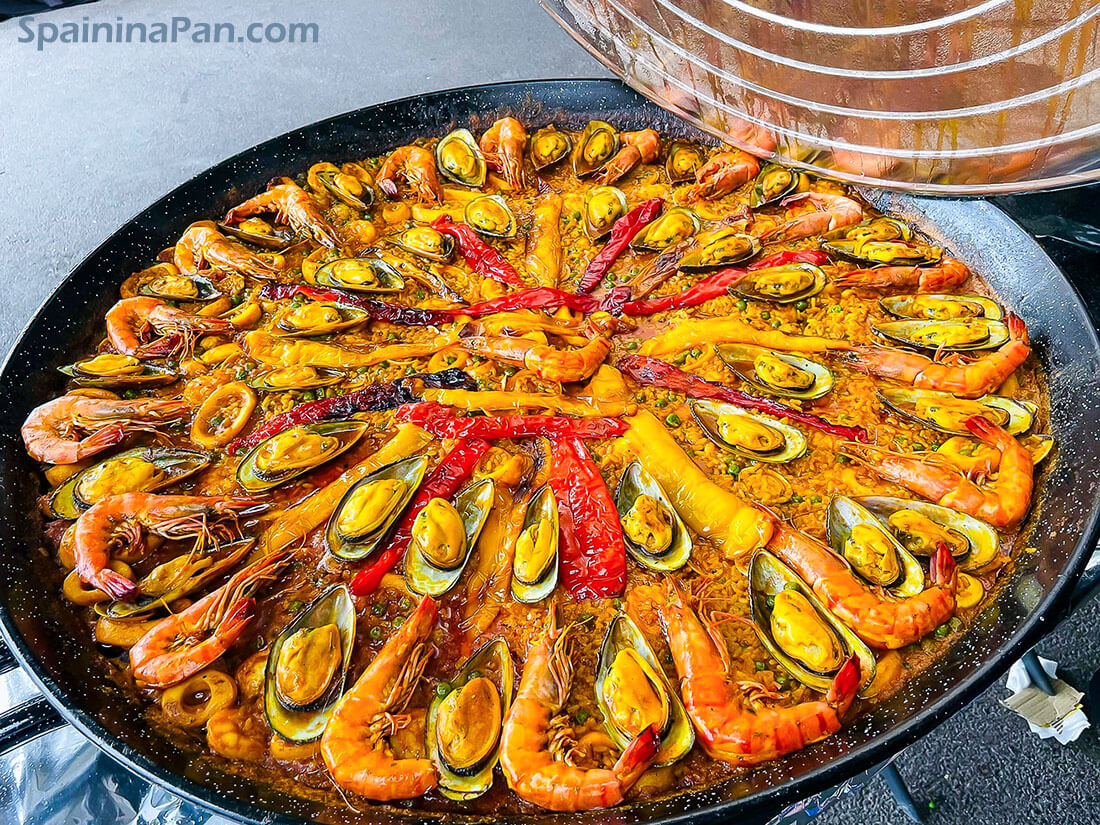 An appetizing seafood paella
An appetizing seafood paella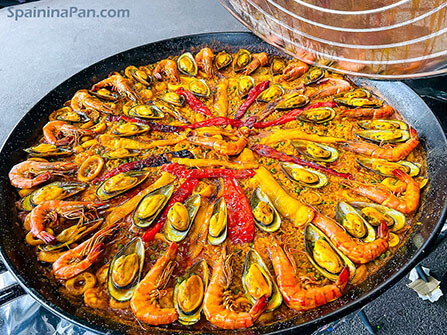 An appetizing seafood paella
An appetizing seafood paella
Five Main Techniques:
1. The Amount of Rice Secret
The purpose is to know how much rice should go in paella pans of any size. The wrong amount can burn on the edges, not cook on the top part, or turn into a paste on the bottom.
- Put a thin layer of rice in the pan. For reference, this is approximately two rice grains on their side high. (approx. 0.5 cm or 0.2 inch high)
A thin layer may not look like much. Trust me! Once the rice swells up, you'll change your mind. As said, the wrong amount may NOT cook evenly or burn.
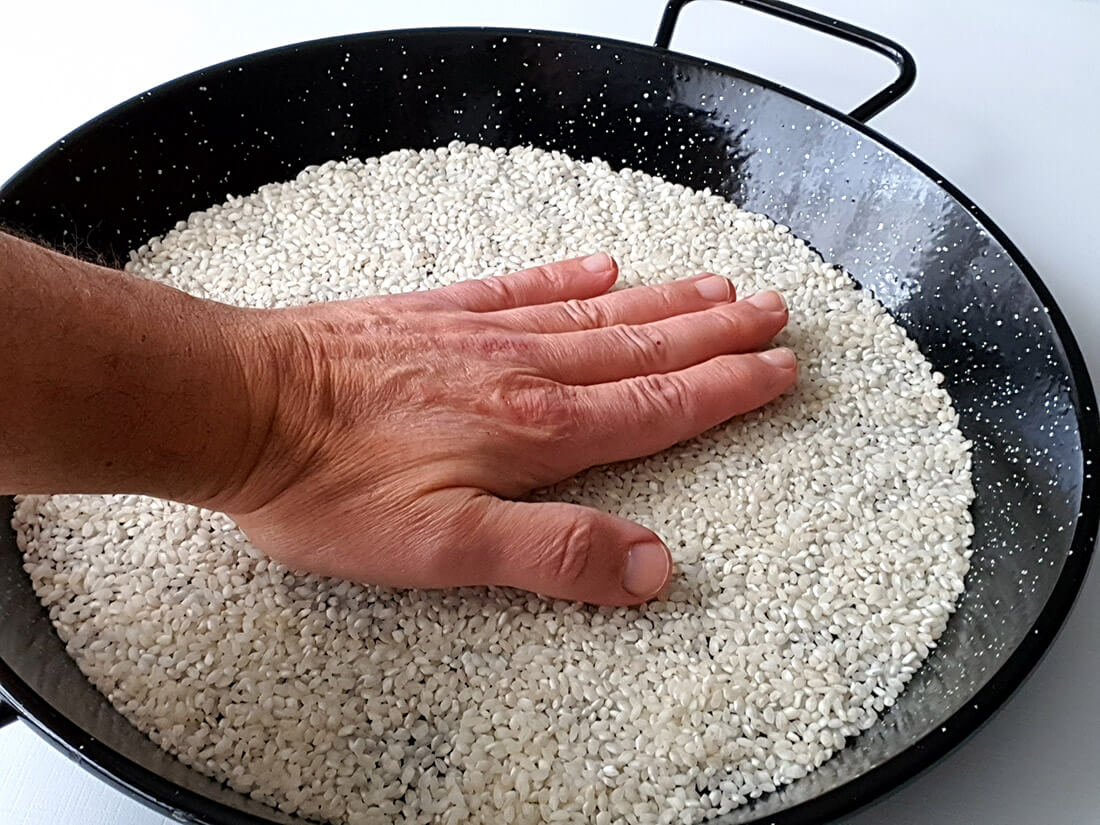 1. Flatten rice layer to 2 grains thick. Pan enamel is still visible through the rice.
1. Flatten rice layer to 2 grains thick. Pan enamel is still visible through the rice.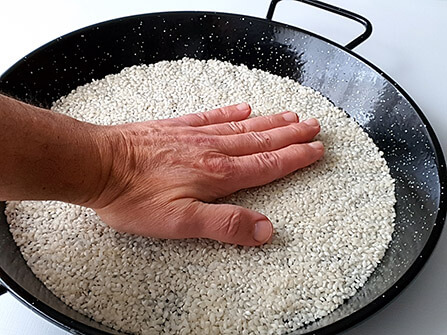 1. Flatten rice layer to 2 grains thick. Pan enamel is still visible through the rice.
1. Flatten rice layer to 2 grains thick. Pan enamel is still visible through the rice.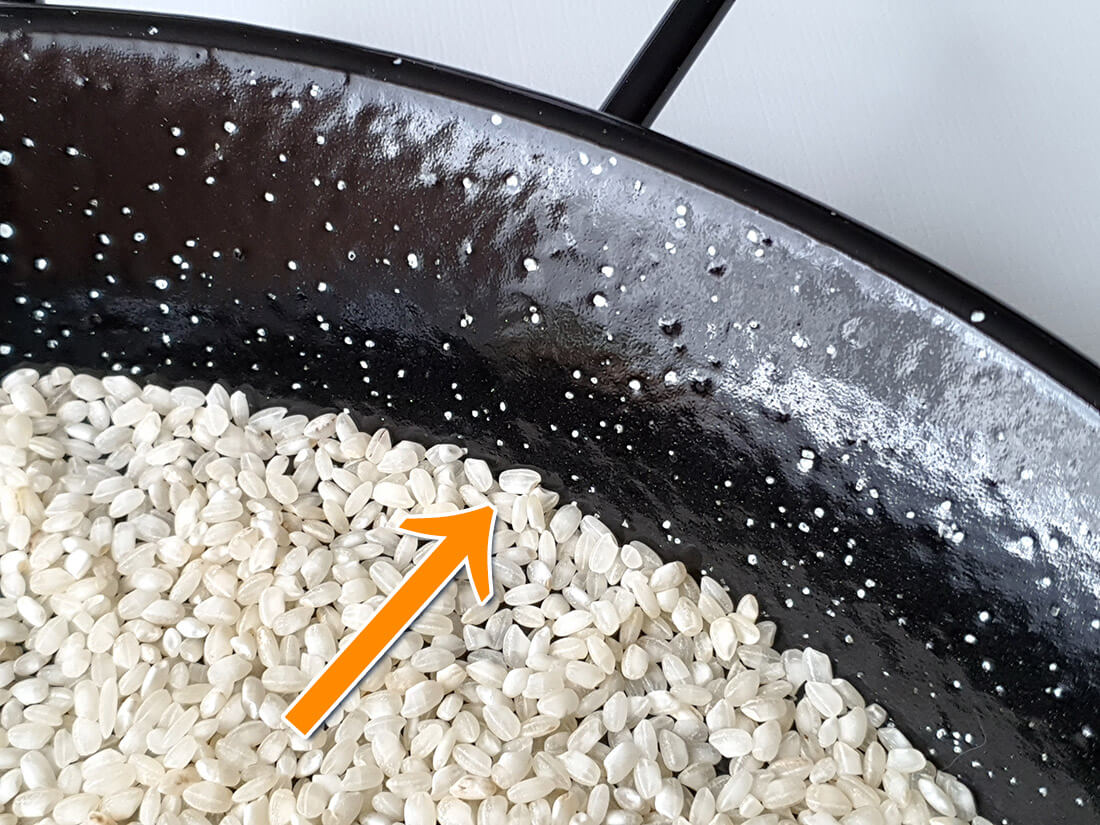 2. The rice must touch the sides of the pan.
2. The rice must touch the sides of the pan.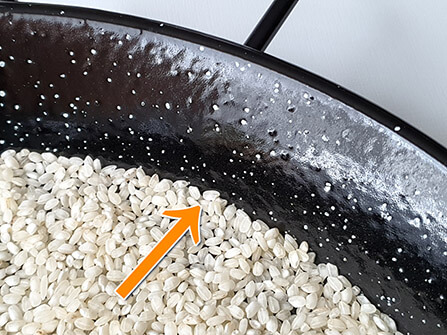 2. The rice needs to touch the sides of the pan.
2. The rice needs to touch the sides of the pan.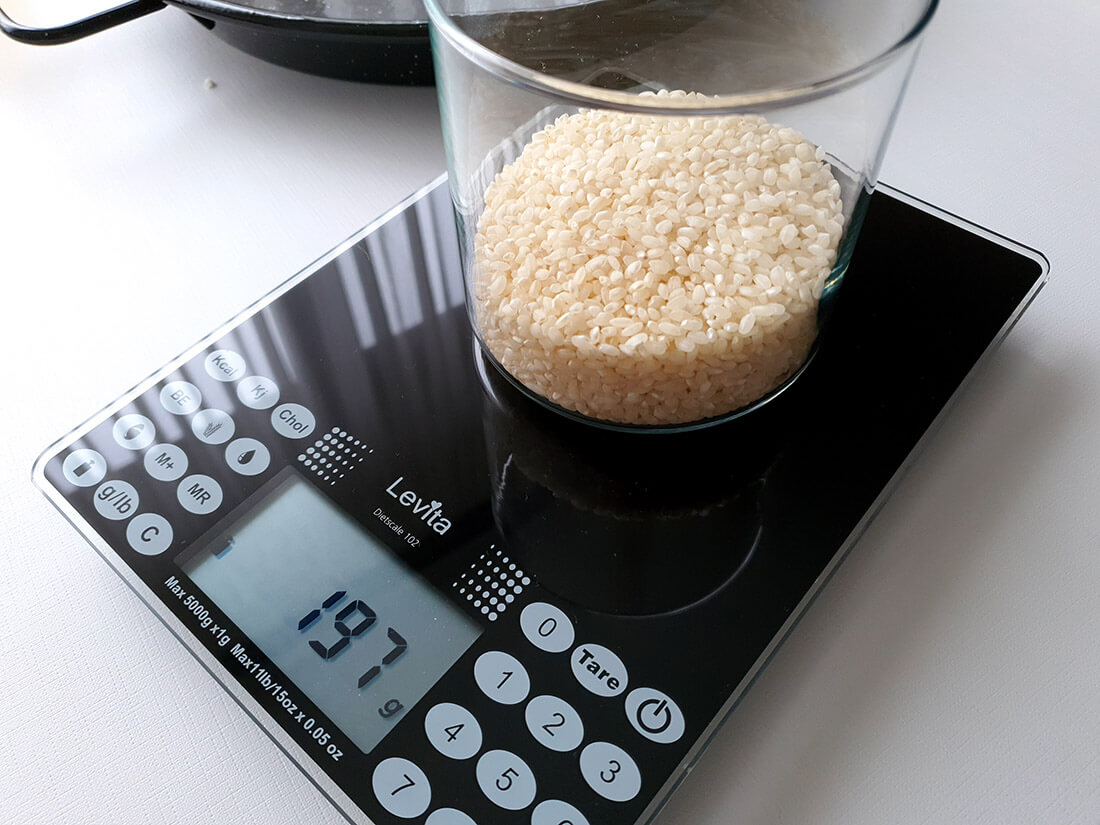 3. Weigh the rice! It should be 200g/7 oz or close to it.
3. Weigh the rice! It should be 200g/7 oz or close to it. 3. Weigh the rice! It should be 200g/7 oz or close to it.
3. Weigh the rice! It should be 200g/7 oz or close to it.- Spread the grains by lightly pressing them with the palm of your hand, until they touch the sides of the pan. Add or remove rice if necessary.
- The rice layer MUST touch the sides of the pan. Leaving a gap can cause the rice to char at the edge, giving a slightly bitter taste.
- When done, remove the rice from the pan and measure its weight. This number helps us to know how much cooking water (or broth) we need.
Experienced- and master chefs use this technique to balance the pan size with the right amount of rice.
A major step on how to make paella outstanding, and you only have to weigh the rice once.
2. The Amount of Water Secret
The standard ratio for home cooking is 3 parts of water for 1 part of Bomba rice. So with 400g/14oz of rice (4 servings), you'd need 1.2L/40.5fl oz of water (400gx3/14oz x 3).
On a hot day, use a little more. I suggest 3.5 parts water for 1 part rice.
Some chefs use the rivets of the pan as a reference. That's an option, but only if you know what you're doing and when using the same pan.
I don't consider it the best technique since you may use different ingredients the next time. It could change the water level.
Some professional chefs have a more calculated approach. They first figure out how much rice is needed. Let's say 400g/14 oz, like in the example above.
Next step! We can assume the rice will absorb at least its own weight in water. The problem? We don't know how much water will evaporate during the boil.
- Pour water into the pan, at least 3 times the weight of the rice. That makes 3 x 400g/14oz = 1.2L/40.5fl oz water. Round it up to 1.5L/51 fl oz.
At this point, it really doesn't matter the exact amount. We need to know how much evaporates.
- Turn the fire to high and wait until the water boils. Set a timer to 10 minutes. Turn the fire down to low, and continue for another 8 minutes. We're simulating the 18-minute cooking process for Bomba rice.
- For the socarrat (if this is what you want), boil for another 90 seconds on high fire.
- Pour the water into a measuring beaker. If there was, for example, 0.5L/17fl oz left, it means that from the initial 2L/67.5fl oz, about 1.5L/51fl oz evaporated. We need the latter number!
- So we got 400ml/14fl oz (the rice weight) of water and another 1.5L/51fl oz that evaporated. Add these two up 0.4L+1.5L (14fl oz + 51fl oz), and you get a total of 1.9L (64.5 fl oz) of water.
That's how much you need to cook 400g/14oz of rice. This is an example! In real life, of course, the numbers are different. But it's the most accurate technique.
Numbers may vary depending on the equipment, your handling, and atmospheric conditions.
Knowing your rice-to-water ratios is crucial, in how to make paella match the one from a Valencian chef. It's half the job.
3. The Sauté (Sofrito) Secret
The sofrito is vital. For a paella Valenciana, I use tomatoes, garlic, and paprika. Sometimes parsley. This dish NEVER includes onion!
There's no magic in making a good sofrito.
- After browning the meat on medium fire and adding the beans, make an opening to add the tomatoes with the garlic and paprika. The standard is one minced garlic clove for each person.
- On medium fire, stir the sofrito until the juice of the tomatoes evaporates. It should look like a concentrated puree. That's it! Now you can stir all the ingredients together.
Some chefs let the sofrito brown, which is okay. Each their taste!
The browned pieces and fat of the meat with the tomato mix already give that unique touch to the paella.
You must use enough sauté as it enhances the final taste. For the same reason, some cooks use broth instead of water to cook the rice.
For an authentic Valencian paella, use only water. There are paella chefs who will swear by "hard" water. However, the difference is negligible.
Some of you want authenticity, so I'm letting you know. Once I wondered too what makes paella Valenciana authentic. You can read it on this link.
- Another vital point, the sofrito also includes the moment of browning the meats. They have to be well cooked. Crispy and brown, not tan or golden!
4. The Socarrat Secret
As you may know, the socarrat (in Valencia, socarradet) is that crusty, browned layer underneath the rice. I just love the texture and savory taste of it!
- When the Bomba rice is done and the socarrat isn't there, increase the fire to high and cook for around 90 seconds.
- Listen to a sizzling sound becoming louder, letting you know the rice is becoming crispy underneath. Just be careful not to char the grains.
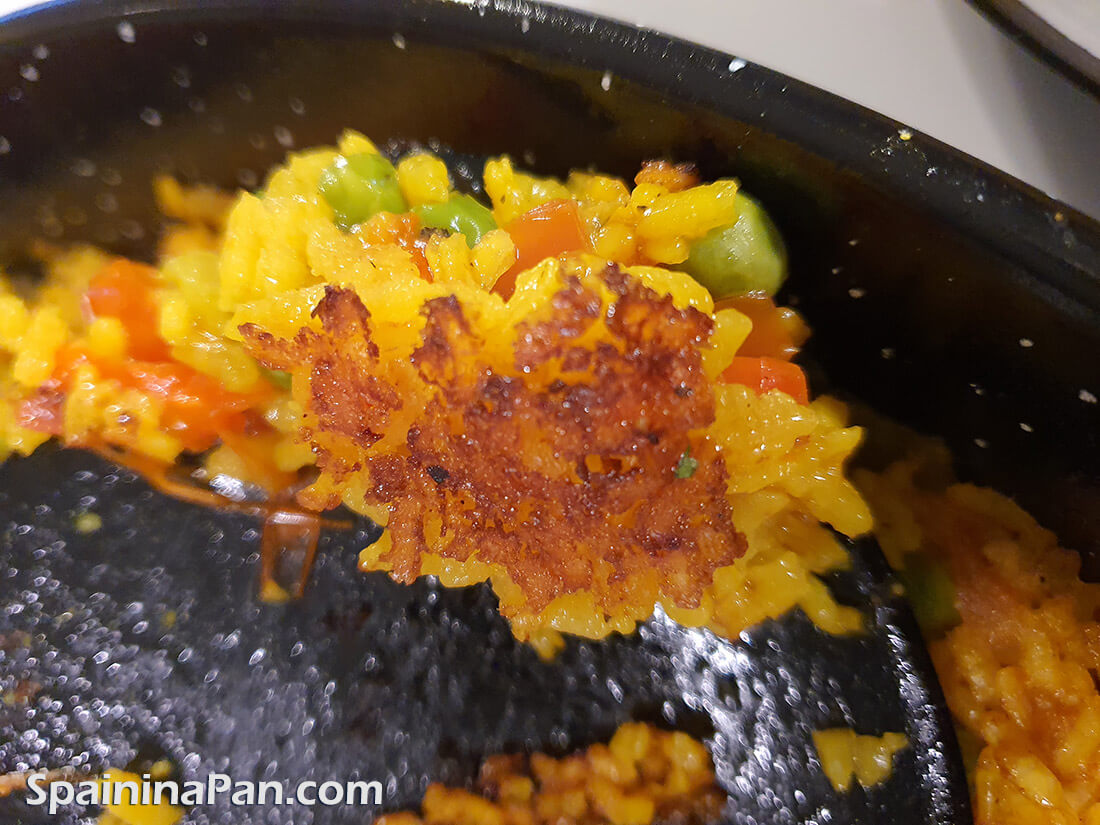 The crispy socarrat underneath the paella rice.
The crispy socarrat underneath the paella rice.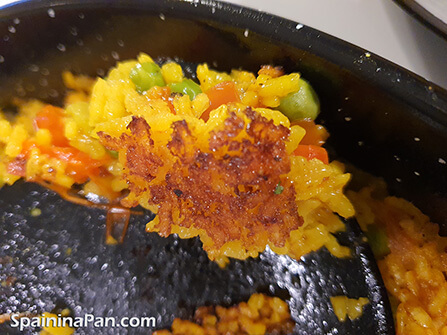 The crispy socarrat underneath the paella rice.
The crispy socarrat underneath the paella rice.
A quick trick to use: insert a narrow cooking spatula until it touches the bottom of the pan. It allows a peek to see if the socarrat is there.
If you don't care for this layer, know that it adds an extra savory taste to the dish.
A black, burned socarrat dulls the taste. I don't consider these paellas the best, but some people may enjoy them.
5. The Yellow Coloring Secret
Saffron is probably the most important spice for paella. That's what gives the dish a yellowish color and that distinct taste.
Saffron is never overdone! The light hint of peppery sweetness makes the dish what it is. But too much of it may make some people frown.
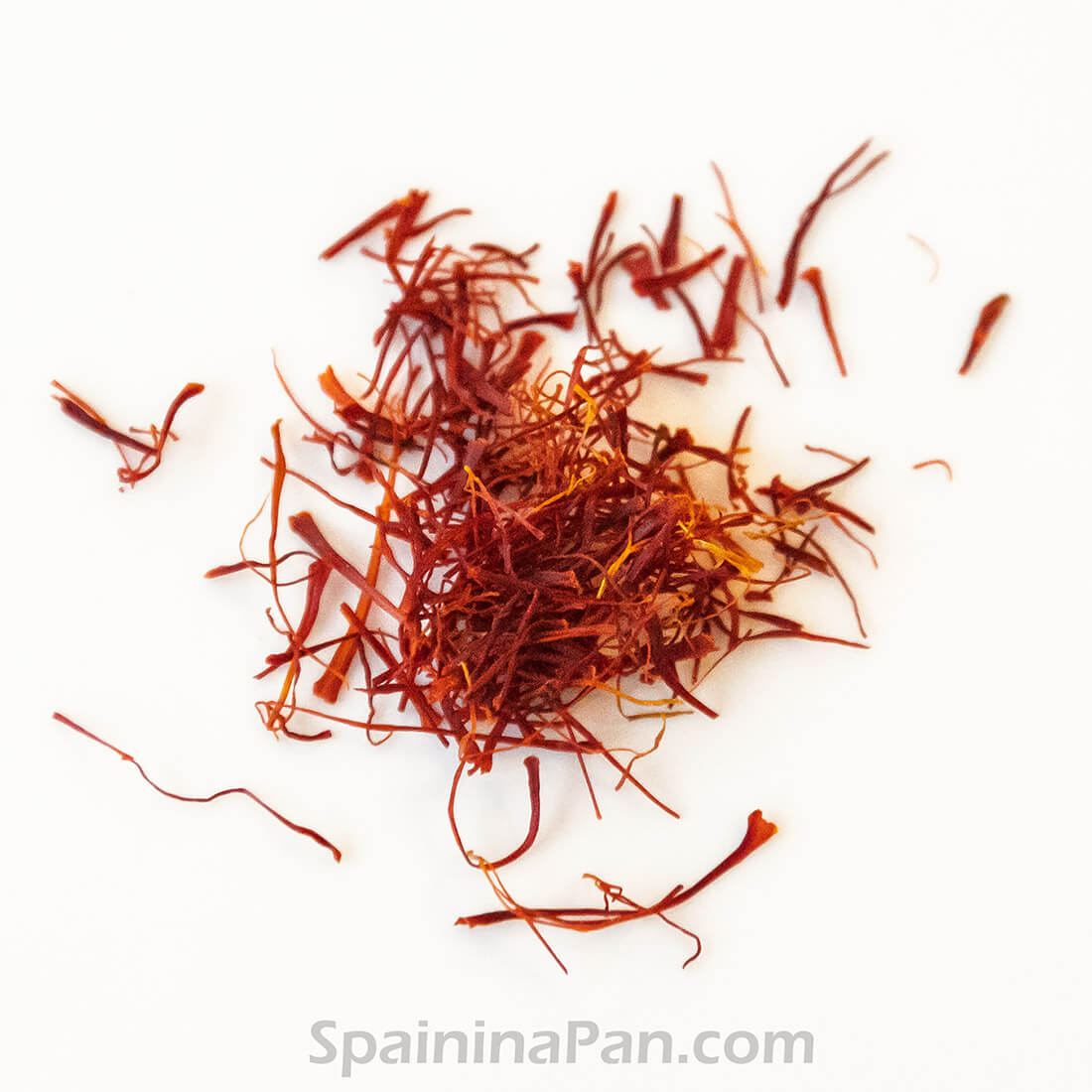 Saffron threads
Saffron threads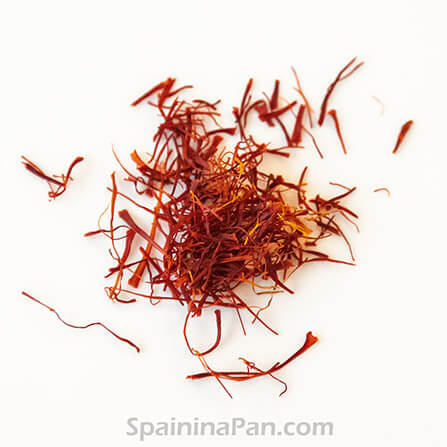 Saffron threads
Saffron threads
I can usually tell when a paella is made with saffron or yellow food dye. Not just by tasting. Light yellow rice usually hints at saffron, while bright yellow is often the dye version.
Unless, of course, a saffron-dye powder mix was used. A paella Valenciana, the authentic one, is rarely bright yellow. Use 4 to 5 strings of saffron per serving.
But I understand the eyes want something too. In that case, food dye doesn't add much taste, so more can be used.
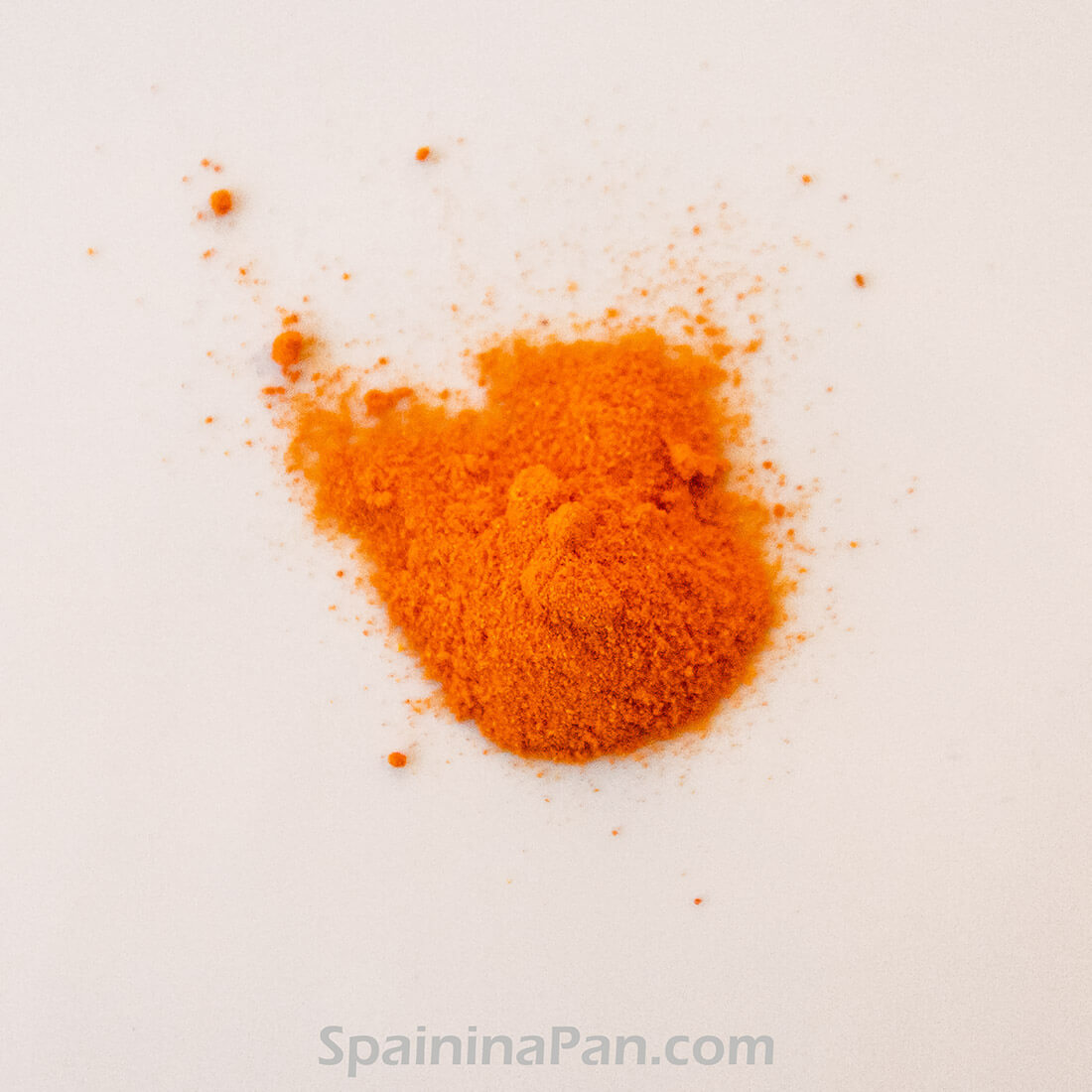 Yellow food-dye
Yellow food-dye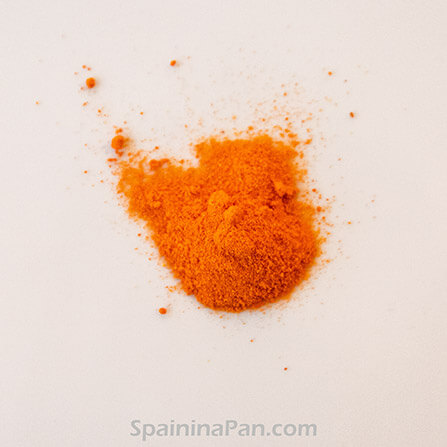 Yellow food-dye
Yellow food-dye
For saffron, I do recommend lightly toasting and grinding over infusing it in a water bottle. It keeps much longer and colors the broth immediately.
Saffron strings in tap water take hours to release their full yellow-orange color.
Once you know how to make paella like in Valencia, you will have another reason to get together with loved ones. The techniques above will surely help.
After all, it's the dish of togetherness and celebration.
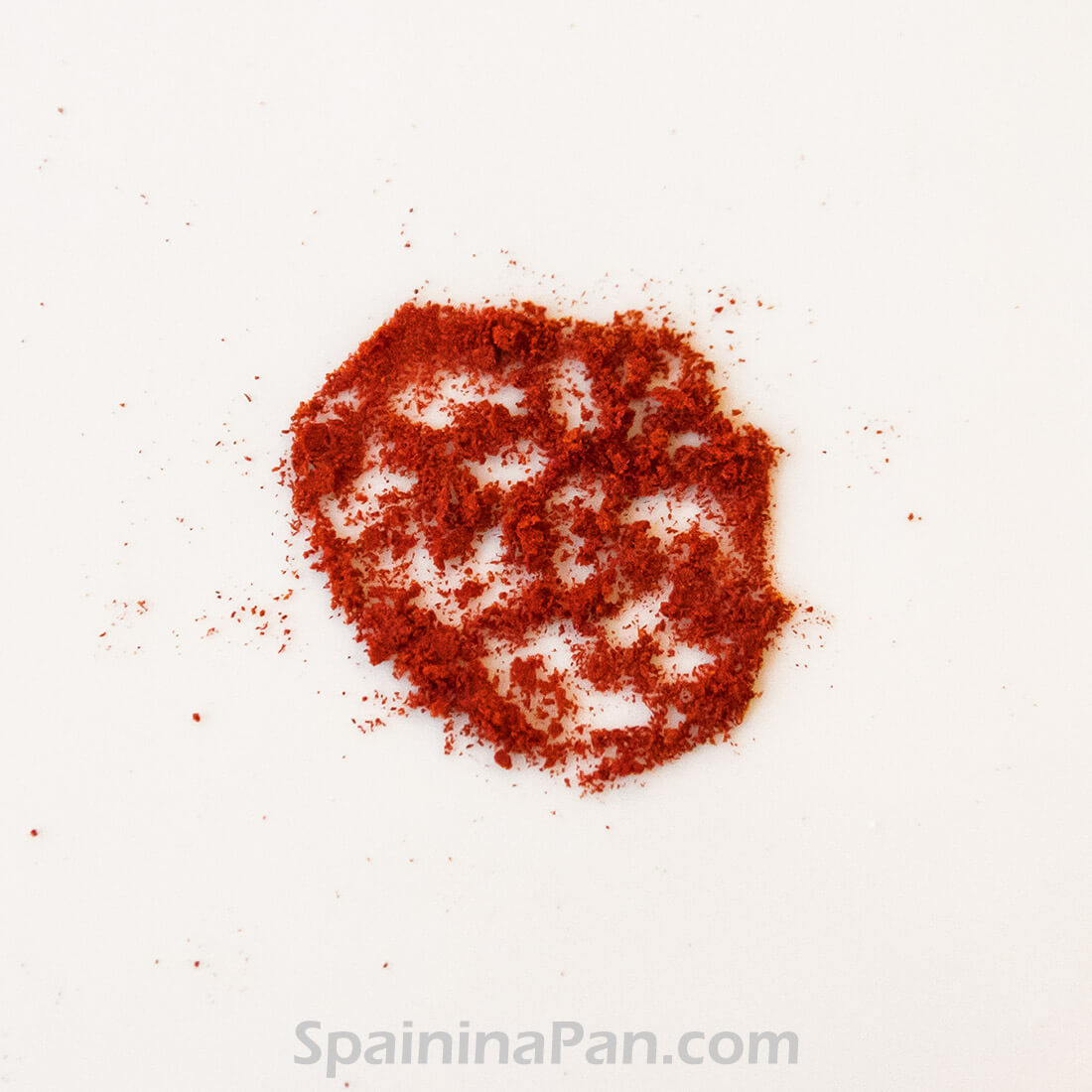 Ground saffron
Ground saffron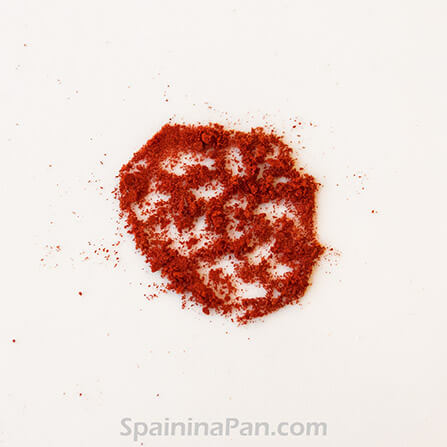 Ground saffron
Ground saffron*****
